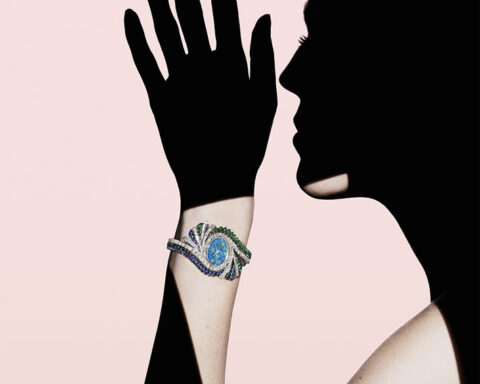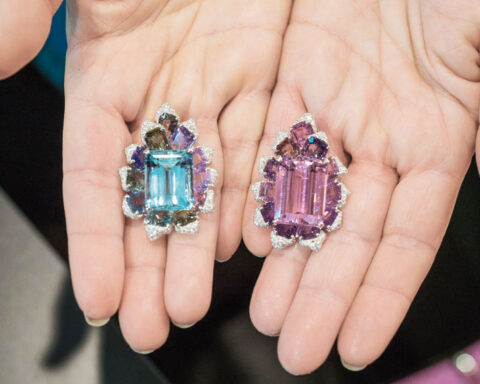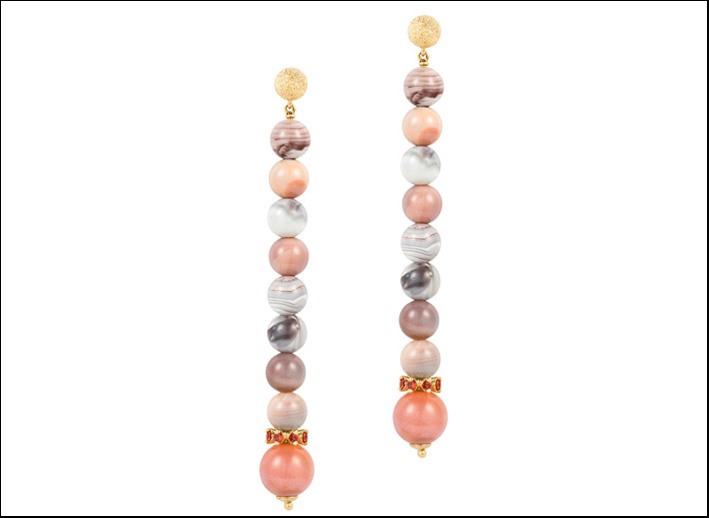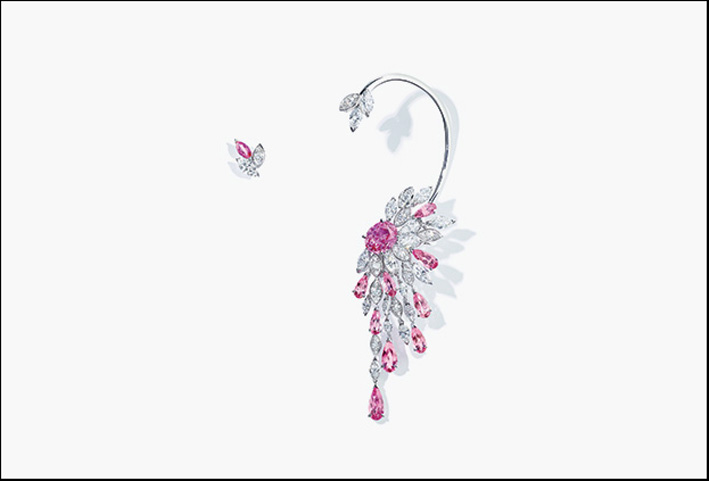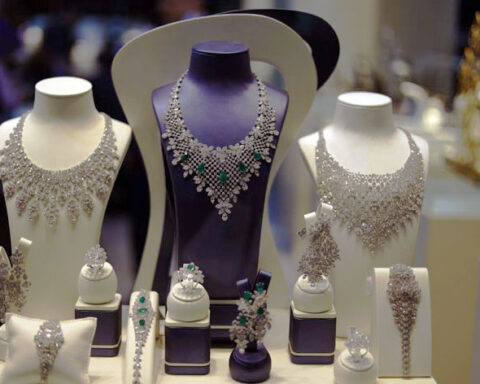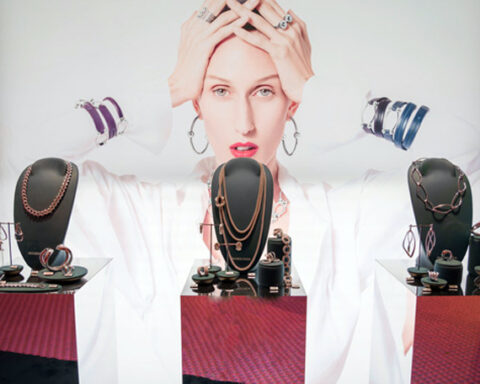Pierre Arpels (1919-1980) could not believe the riches that lay before his eyes! Hundreds – if not thousands – of emeralds, of all shapes and sizes, were gathered on the glass shelves of a display case. “I stood in wonder before this treasure, this profusion of precious stones,” he later said.
There were too many to count! And besides, he did not have time. The Iranian government had commissioned Van Cleef & Arpels to create several jewelry sets – including the Empress’s crown – for the coming coronation. “In November 1966, the governor of the Bank of Iran came to see us,” Pierre Arpels would explain. “He asked us if we could prepare several designs for a crown.”
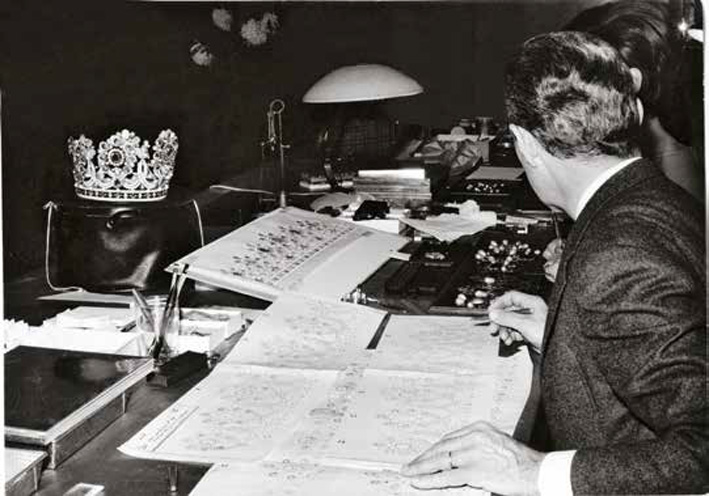
On December 16, the Maison was informed that the Empress had selected one of its designs. Accompanied by a team of jewelers, Pierre Arpels traveled to Iran immediately to start work without delay. The coronation was scheduled for November, leaving him less than eleven months to create the piece. On this first trip, he intended to make a rapid but precise selection of the major stones to be used for the Empress’s crown.
Very quickly, the jeweler settled on two of the treasury’s most beautiful emeralds: a shell-shaped stone weighing over 50 carats and a hexagonal one of 150 carats, both of them engraved. In all, 143 emeralds were chosen, along with thousands of diamonds and several colored stones.
The initial order was supplemented by a second one for several complete jewelry sets – necklaces, diadems and earrings – also set with emeralds and diamonds and destined to be worn by the princesses of the imperial family. Finally, in September 1967, a third order – a necklace and a pair of earrings for the Empress – was received: it was to be created in the space of two months. A design was produced in record time, centered on a hexagonal emerald weighing 200 carats. In all, nearly 2,000 carats of emeralds were set in the imperial jewels. On October 26, 1967, the ceremony was broadcast across the world. The Shah of Iran placed the crown created by Van Cleef & Arpels on Shahbanu Farah’s head. The event marked the high point of the remarkable relationship that has always existed between emeralds and Van Cleef & Arpels.
The Duchess of Windsor (1896-1986) was one of the first clients to illustrate this special bond. In 1936 she lived in London, where she was one of the British capital’s most prominent socialites. Above all, she embarked on an extraordinary love story with one of the most famous men on the planet – King Edward VIII (1894-1972). Their relationship, first kept secret because of Wallis’s marriage, burst into the public eye in the course of 1936. The king was madly in love with this elegant American and showered her with sumptuous gifts. They were often purchased in Paris, at Van Cleef & Arpels, whose innovative style was much appreciated by Mrs Simpson. One of the first dates from 1935: a double-strand necklace of rectangular diamonds, set with 17 emeralds weighing a total of 70 carats.
Two years later, King Edward VIII abdicated to marry the woman he loved. Edward and Wallis, now the Duke and Duchess of Windsor, were married in France, where they lived. Needless to say, the Duke went on presenting his wife with the most magnificent jewels. In December 1937, he acquired a remarkable Van Cleef & Arpels bracelet in gold with black lacquer, set with a flower made up of diamonds, rubies and five large pear-shaped emeralds, whose weights range from 7 to 14 carats.

During the same period, another diamond and emerald necklace – which still exists in its original form – was acquired by one of Van Cleef & Arpels’ illustrious clients: Princess Faiza of Egypt, the sister of King Farouk. A woman of great elegance who owned a highly original collection of jewelry, she appreciated the combination of old stones with more contemporary settings.
The necklace that she bought in 1929 was modified in the late 1930s. It takes the form of a highly flexible choker, whose diamond droplets are set with nine old emerald pendeloques. A tenth emerald is positioned at the back of the jewel on a particularly ornate clasp. Princess Faiza often wore her emerald necklace at balls held in Paris and Cairo or on the Côte d’Azur. Having been acquired by a new owner, the piece reappeared at auction in November 2013, at Christie’s in Geneva. It was purchased by Van Cleef & Arpels for its private collection.
In 1946, Jacques Arpels (1914-2008) – Pierre’s brother – became the hero of another episode in the emerald saga, when he received the first order from a woman who was without doubt the Maison’s most extraordinary client: H.H. the Maharani of Baroda (1917-1989). A woman of seductive beauty, Princess Sita Devi was a legend in India. Following an extraordinary to-and-fro of marriages, divorces and changes of religion, she married one of the country’s richest men, the Maharaja of Baroda. The Maharani elected to live in Paris. Although she dressed in the Indian style – in magnificent saris – she preferred to wear European jewelry. Over the course of 20 years, she had practically her entire collection reset by Van Cleef & Arpels. Within it, emeralds occupied a prominent place.
The first jewel created for her was a brooch set with a large engraved emerald, incrusted with rubies in typically Mughal style. In 1950, Jacques Arpels designed a legendary jewel from a collection of emeralds made up of 13 pendeloques weighing 155 carats and 36 beads weighing 51 carats. With its lotus motif, this necklace is regularly exhibited at Van Cleef & Arpels retrospectives. To accompany it, Jacques Arpels went on to create three pairs of ear pendants set with diamonds and emeralds.
Twenty years later, in 1971, another treasure worthy of the Arabian Nights arrived at Van Cleef & Arpels’ premises in Place Vendôme. Princess Salimah, the first wife of the Aga Khan IV, entrusted the Maison with an extraordinary set of 58 ribbed emeralds: fabulous green stones with grooves engraved on every side. They were used to create a long necklace and a pair of earrings. The long necklace is transformable. Its rear portion can be worn as a bracelet and its pendant as a clip. In 1995, Princess Salimah auctioned this piece at Christie’s in Geneva; it now belongs to Van Cleef & Arpels’ private collection.


